
A tongue-twister activity for theatre students.
- Subject:
- Performing Arts
- Material Type:
- Activity/Lab
- Author:
- Red Rocks CC
- Date Added:
- 07/10/2024

A tongue-twister activity for theatre students.

This resource was created by Jill Anderson, in collaboration with Dawn DeTurk, Hannah Blomstedt, and Julie Albrecht, as part of ESU2's Integrating the Arts project. This project is a four year initiative focused on integrating arts into the core curriculum through teacher education, practice, and coaching.
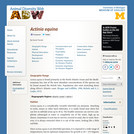
This is an information sheet on the species, Actinia equina, provided by the University of Michigan Museum of Zoology.

This resource is a video abstract of a research paper created by Research Square on behalf of its authors. It provides a synopsis that's easy to understand, and can be used to introduce the topics it covers to students, researchers, and the general public. The video's transcript is also provided in full, with a portion provided below for preview:
"Actinobacteria are some of the most widely distributed bacteria in soils and are well known for their ability to degrade plant residues in pure culture in the laboratory. Yet, despite the importance of microbe-driven decomposition to carbon sequestration in terrestrial systems, their importance and specific activity across diverse environments in the field are unknown. Researchers recently evaluated the ecophysiological roles of Actinobacteria in rice straw residue decomposition in a series of field and microcosm experiments. They found that although Actinobacteria represented only 4.6% of the total bacterial abundance, they encoded 16% of the total carbohydrate-active enzymes (CAZymes) involved in the breakdown of carbohydrates. The researchers also found that Actinobacteria taxonomic and functional compositions were relatively stable during straw decomposition and that the importance of Actinobacteria in decomposition increased as soil fertility decreased..."
The rest of the transcript, along with a link to the research itself, is available on the resource itself.
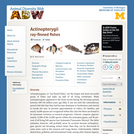
This is an information sheet on the species, Actinopterygii, provided by the University of Michigan Museum of Zoology.
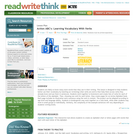
Creating an illustrated alphabet book of action words, from "attack" to "zap", reinforces the definition of verbs as it stretches and expands students' vocabulary.
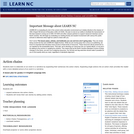
This lesson plan teaches students to elaborate on an event in a narrative by expanding their sentences into action chains. The result is a more detailed picture of an event in a narrative.
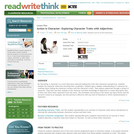
Students must "become" a character in a novel in order to describe themselves and other characters using powerful adjectives.

Using the article "Stop Raising Awareness Already" by Cristiano and Neimand and a six-step template, students create a plan to show how they apply the knowledge learned throughout the term to make a broader impact. The students are asked to very narrowly choose a single action they want a group of stakeholders to take and develop a multiple-step plan to accomplish the action. The students are required to select and justify a targeted stakeholder, develop an action, identify a messenger that can influence their targeted stakeholder to take the action, develop a sticky message relating the "ask" to the goal of the campaign, and document their key assumptions imbedded in their action plan.
(Note: this resource was added to OER Commons as part of a batch upload of over 2,200 records. If you notice an issue with the quality of the metadata, please let us know by using the 'report' button and we will flag it for consideration.)
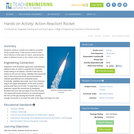
Students construct rockets from balloons propelled along a guide string. They use this model to learn about Newton's three laws of motion, examining the effect of different forces on the motion of the rocket.
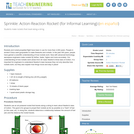
Students make rockets that travel along a string.
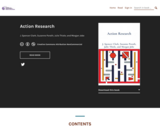
Action research is a common journey for graduate students in education and other human science fields. This book attempts to meet the needs of graduate students, in-service teachers, and any other educators interested in action research and/or self-study. The chapters of this book draw on our collective experiences as educators in a variety of educational contexts, and our roles guiding educator/researchers in various settings. All of our experiences have enabled us to question and refine our own understanding of action research as a process and means for pedagogical improvement.
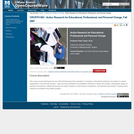
This course covers techniques for and critical thinking about the evaluation of changes in educational practices and policies in schools, organizations, and informal contexts. Topics include quantitative and qualitative methods for design and analysis, participatory design of practices and policies, institutional learning, the wider reception or discounting of evaluations, and selected case studies, including those arising from semester-long student projects.

Short Description:
This text is an OER remix of the following resource: Clark, J. S., Porath, S., Thiele, J., & Jobe, M. (2020). Action research. New Prairie Press.
Word Count: 30262
(Note: This resource's metadata has been created automatically by reformatting and/or combining the information that the author initially provided as part of a bulk import process.)
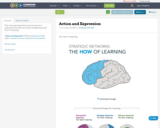
This visual representation is away for parents to understand how UDL uses Action and Expression (the "How" of learning)
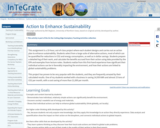
This assignment is a 10-hour, out-of-class project where each student
designs and carries out an action plan to enhance sustainability.
Students select from a large suite of alternative actions, most of which
can be quantified for reductions in CO2 and energy consumption, as well
as in dollar savings.
(Note: this resource was added to OER Commons as part of a batch upload of over 2,200 records. If you notice an issue with the quality of the metadata, please let us know by using the 'report' button and we will flag it for consideration.)

This resource was created by Emily Cameron, in collaboration with Dawn DeTurk, Hannah Blomstedt, and Julie Albrecht, as part of ESU2's Integrating the Arts project. This project is a four year initiative focused on integrating arts into the core curriculum through teacher education, practice, and coaching.
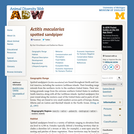
This is an information sheet on the species, Actitis macularia, provided by the University of Michigan Museum of Zoology.

This resource is a video abstract of a research paper created by Research Square on behalf of its authors. It provides a synopsis that's easy to understand, and can be used to introduce the topics it covers to students, researchers, and the general public. The video's transcript is also provided in full, with a portion provided below for preview:
"Humans rely on microbial communities in both natural and applied settings. One such applied setting is wastewater treatment plants, which use microbial communities to remove pollutants. However, the stability of the taxonomic diversity in these settings is not well understood. To close this gap, researchers examined how the microbial community in activated sludge changed over time in a full-scale wastewater treatment plant. For the first 3 years of a 9-year series, the microbial community fluctuated around a stable average. Then a bleaching event, marked in red under the timeline, abruptly pushed the community to an alternative stable state, where the originally dominant Actinobacteriota were disproportionally depleted and replaced with Proteobacteria, but these taxonomic changes led to little change in either the metabolic profile of the community or system performance. In a fine-scale analysis of dynamics, the researchers identified cohorts that dominated at different periods..."
The rest of the transcript, along with a link to the research itself, is available on the resource itself.

This resource is a video abstract of a research paper created by Research Square on behalf of its authors. It provides a synopsis that's easy to understand, and can be used to introduce the topics it covers to students, researchers, and the general public. The video's transcript is also provided in full, with a portion provided below for preview:
"Acute myeloid leukemia (AML) is a type of blood and bone marrow cancer with a low survival rate. One reason AML is so deadly is because it can evade the immune system, in part by downregulating proteins like MICA, which normally marks damaged or cancerous cells in the body for immune destruction. To improve treatment prospects, researchers recently searched for molecules that can restore MICA levels in AML cells. They found that the transcription factor KFL4 is involved in MICA expression. In addition, treating cultured AML cells with the KLF4-activating compound APTO253 successfully induced MICA expression, while inhibiting the expression of the cancer gene MYC. These changes made the AML cells more susceptible to being killed by immune cells. Although studies in animals and humans are still needed, these findings reveal that APTO253 can improve immune cells’ ability to detect and kill AML cells and suggest that targeting KFL4/MICA is a promising option for AML treatment..."
The rest of the transcript, along with a link to the research itself, is available on the resource itself.